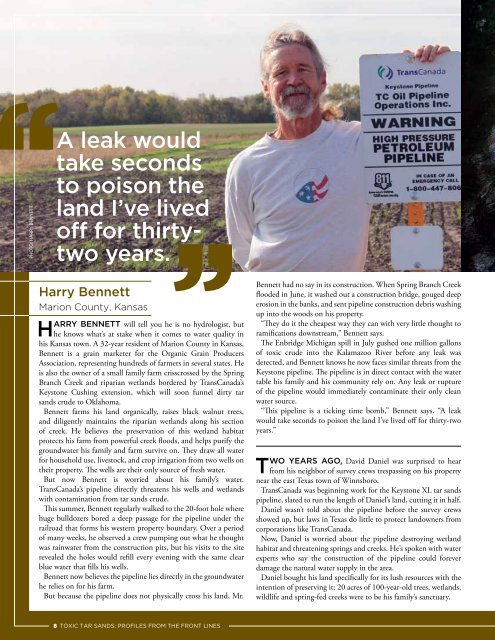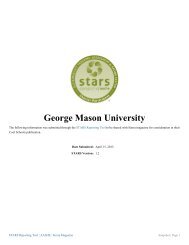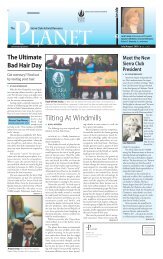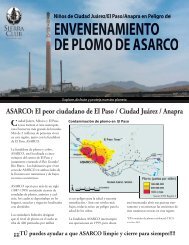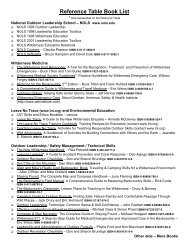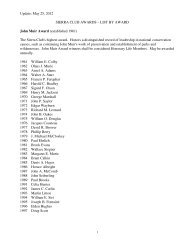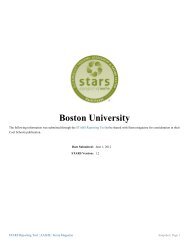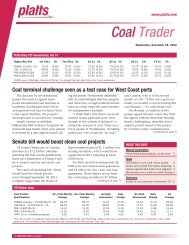Toxic Tar Sands: Profiles from the Front Lines - Sierra Club
Toxic Tar Sands: Profiles from the Front Lines - Sierra Club
Toxic Tar Sands: Profiles from the Front Lines - Sierra Club
You also want an ePaper? Increase the reach of your titles
YUMPU automatically turns print PDFs into web optimized ePapers that Google loves.
PHoTo: HARRy BENNETT<br />
A leak would<br />
take seconds<br />
to poison <strong>the</strong><br />
land i’ve lived<br />
off for thirtytwo<br />
years.<br />
Harry Bennett<br />
Marion County, Kansas<br />
HArry Bennett will tell you he is no hydrologist, but<br />
he knows what’s at stake when it comes to water quality in<br />
his Kansas town. A 32-year resident of Marion County in Kansas,<br />
Bennett is a grain marketer for <strong>the</strong> Organic Grain Producers<br />
Association, representing hundreds of farmers in several states. He<br />
is also <strong>the</strong> owner of a small family farm crisscrossed by <strong>the</strong> Spring<br />
Branch Creek and riparian wetlands bordered by TransCanada’s<br />
Keystone Cushing extension, which will soon funnel dirty tar<br />
sands crude to Oklahoma.<br />
Bennett farms his land organically, raises black walnut trees,<br />
and diligently maintains <strong>the</strong> riparian wetlands along his section<br />
of creek. He believes <strong>the</strong> preservation of this wetland habitat<br />
protects his farm <strong>from</strong> powerful creek floods, and helps purify <strong>the</strong><br />
groundwater his family and farm survive on. They draw all water<br />
for household use, livestock, and crop irrigation <strong>from</strong> two wells on<br />
<strong>the</strong>ir property. The wells are <strong>the</strong>ir only source of fresh water.<br />
But now Bennett is worried about his family’s water.<br />
TransCanada’s pipeline directly threatens his wells and wetlands<br />
with contamination <strong>from</strong> tar sands crude.<br />
This summer, Bennett regularly walked to <strong>the</strong> 20-foot hole where<br />
huge bulldozers bored a deep passage for <strong>the</strong> pipeline under <strong>the</strong><br />
railroad that forms his western property boundary. Over a period<br />
of many weeks, he observed a crew pumping out what he thought<br />
was rainwater <strong>from</strong> <strong>the</strong> construction pits, but his visits to <strong>the</strong> site<br />
revealed <strong>the</strong> holes would refill every evening with <strong>the</strong> same clear<br />
blue water that fills his wells.<br />
Bennett now believes <strong>the</strong> pipeline lies directly in <strong>the</strong> groundwater<br />
he relies on for his farm.<br />
But because <strong>the</strong> pipeline does not physically cross his land, Mr.<br />
8 TOXIC TAR SANDS: PROFILES FROM THE FRONT LINES<br />
Bennett had no say in its construction. When Spring Branch Creek<br />
flooded in June, it washed out a construction bridge, gouged deep<br />
erosion in <strong>the</strong> banks, and sent pipeline construction debris washing<br />
up into <strong>the</strong> woods on his property.<br />
“They do it <strong>the</strong> cheapest way <strong>the</strong>y can with very little thought to<br />
ramifications downstream,” Bennett says.<br />
The Enbridge Michigan spill in July gushed one million gallons<br />
of toxic crude into <strong>the</strong> Kalamazoo River before any leak was<br />
detected, and Bennett knows he now faces similar threats <strong>from</strong> <strong>the</strong><br />
Keystone pipeline. The pipeline is in direct contact with <strong>the</strong> water<br />
table his family and his community rely on. Any leak or rupture<br />
of <strong>the</strong> pipeline would immediately contaminate <strong>the</strong>ir only clean<br />
water source.<br />
“This pipeline is a ticking time bomb,” Bennett says. “A leak<br />
would take seconds to poison <strong>the</strong> land I’ve lived off for thirty-two<br />
years.”<br />
two yeArs Ago, David Daniel was surprised to hear<br />
<strong>from</strong> his neighbor of survey crews trespassing on his property<br />
near <strong>the</strong> east Texas town of Winnsboro.<br />
TransCanada was beginning work for <strong>the</strong> Keystone XL tar sands<br />
pipeline, slated to run <strong>the</strong> length of Daniel’s land, cutting it in half.<br />
Daniel wasn’t told about <strong>the</strong> pipeline before <strong>the</strong> survey crews<br />
showed up, but laws in Texas do little to protect landowners <strong>from</strong><br />
corporations like TransCanada.<br />
Now, Daniel is worried about <strong>the</strong> pipeline destroying wetland<br />
habitat and threatening springs and creeks. He’s spoken with water<br />
experts who say <strong>the</strong> construction of <strong>the</strong> pipeline could forever<br />
damage <strong>the</strong> natural water supply in <strong>the</strong> area.<br />
Daniel bought his land specifically for its lush resources with <strong>the</strong><br />
intention of preserving it; 20 acres of 100-year-old trees, wetlands,<br />
wildlife and spring-fed creeks were to be his family’s sanctuary.


